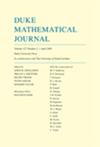随机图k核的奇异性
IF 3
1区 数学
Q1 MATHEMATICS
引用次数: 7
摘要
已知非常稀疏的随机图通常是奇异的(即具有奇异邻接矩阵),由于存在“低度依赖性”,如孤立顶点和具有相同邻域的一对1度顶点。我们证明了这些类型的依赖性在某种意义上是奇异性的唯一原因:对于常数$k\ge3$和$\lambda>0$,Erd\H os-R\'enyi随机图$G\sim\mathbb{G}(n,\lambda/n)具有$n$顶点和边概率$\lambda/n$的$通常具有其$k$核(其最小度至少为$k$的最大子图)是非奇异的性质。这解决了2014年国际数学家大会上Vu的一个猜想,并为密度为$O(1/n)$的“极稀疏”随机矩阵的已知非奇异性定理添加了一个简短的列表。我们证明的一个关键方面是提取高阶顶点并使用它们来“提高”秩的技术,从由Bordnave、Lelarge和Salez引起的(非定量的)谱收敛机制可获得的近似秩界开始。本文章由计算机程序翻译,如有差异,请以英文原文为准。
Singularity of the k-core of a random graph
Very sparse random graphs are known to typically be singular (i.e., have singular adjacency matrix), due to the presence of"low-degree dependencies'' such as isolated vertices and pairs of degree-1 vertices with the same neighbourhood. We prove that these kinds of dependencies are in some sense the only causes of singularity: for constants $k\ge 3$ and $\lambda>0$, an Erd\H os--R\'enyi random graph $G\sim\mathbb{G}(n,\lambda/n)$ with $n$ vertices and edge probability $\lambda/n$ typically has the property that its $k$-core (its largest subgraph with minimum degree at least $k$) is nonsingular. This resolves a conjecture of Vu from the 2014 International Congress of Mathematicians, and adds to a short list of known nonsingularity theorems for"extremely sparse'' random matrices with density $O(1/n)$. A key aspect of our proof is a technique to extract high-degree vertices and use them to"boost'' the rank, starting from approximate rank bounds obtainable from (non-quantitative) spectral convergence machinery due to Bordenave, Lelarge and Salez.
求助全文
通过发布文献求助,成功后即可免费获取论文全文。
去求助
来源期刊
CiteScore
3.40
自引率
0.00%
发文量
61
审稿时长
6-12 weeks
期刊介绍:
Information not localized

 求助内容:
求助内容: 应助结果提醒方式:
应助结果提醒方式:


